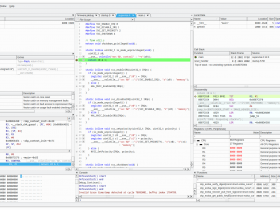I encountered this bug before but wasn't able to reproduce reliably until today.
The bug is that if you put a breakpoint in a place that is somehow special (not sure if it's because of inlining or macros), then after almost each pressing of "continue", there will appear the "Reflashing" window and will reflash numerous times the ELF.
Even if you press the "disconnect" (end session) button, it will first reflash MCU several times before disconnecting.
Example of such breakpoint can be seen on this attached screenshot - if you set it, it will trigger the above bug, once you remove it, Ozone will again work normally without the spurious reflashes:

OS: Ubuntu 20.04 LTS
JLink libraries: 7.64
Ozone: 3.26d
MCU: STM32F427VI
I was trying to find smallest example that triggers it, but could only find this one in Rust for Raspberry Pico: github.com/rp-rs/rp2040-project-template
Breakpoints put on some lines will also trigger the "reflash several times after continue or before disconnect", seems that breakpoints on "info!" lines will cause it as well on second attached screenshot:

The bug is that if you put a breakpoint in a place that is somehow special (not sure if it's because of inlining or macros), then after almost each pressing of "continue", there will appear the "Reflashing" window and will reflash numerous times the ELF.
Even if you press the "disconnect" (end session) button, it will first reflash MCU several times before disconnecting.
Example of such breakpoint can be seen on this attached screenshot - if you set it, it will trigger the above bug, once you remove it, Ozone will again work normally without the spurious reflashes:
OS: Ubuntu 20.04 LTS
JLink libraries: 7.64
Ozone: 3.26d
MCU: STM32F427VI
I was trying to find smallest example that triggers it, but could only find this one in Rust for Raspberry Pico: github.com/rp-rs/rp2040-project-template
Breakpoints put on some lines will also trigger the "reflash several times after continue or before disconnect", seems that breakpoints on "info!" lines will cause it as well on second attached screenshot:



